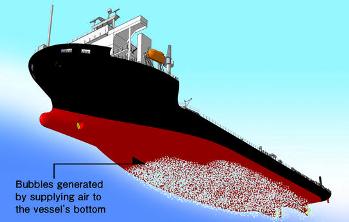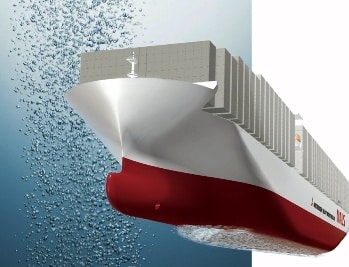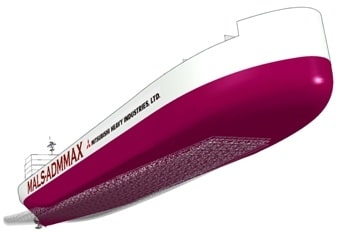How Air Lubrication System for Ships Works?
When Mitsubishi came out with their Air Lubrication System, it was just one of the several energy-saving techniques for ships. The Mitsubishi Air Lubrication System (MALS) was the first system of its kind which promised energy saving and emission reduction from ships using the innovative technology of Air Lubrication.
However, the shipping industry soon realized the potential of the technology, and soon, big players such as NYK Group of Companies and Damen Shipyards Group introduced their own research and experiments on the same.

What is Air Lubrication System for Ships?
Air Lubrication System is a method to reduce the resistance between the ship’s hull and seawater using air bubbles. The air bubble distribution across the hull surface reduces the resistance working on the ship’s hull, creating energy-saving effects. With the right ship hull design, the air lubrication system is expected to achieve up to 10-15% reduction of CO2 emissions, along with significant savings of fuel.
How does Air Lubrication System works?
The Air Lubrication System works on the simple principle of trapping a layer of air bubbles beneath the ship’s hull. An air blower or a dedicated system is used to generate air bubbles to pass them continuously beneath the ship’s surface. Air bubble outlets are created at different locations along the bottom of the hull, symmetrically on both sides of the ship’s centre line.
The air is blown at a constant rate to form a layer of bubbles, which reduces the drag and resistance between the ship and the seawater. The 
Read: What are keel guards?
Concerns about Air Lubrication System
Though a promising technology, the Air Lubrication System has a few concerns regarding its implementation and performance on ships. Some of the main ones are:
- The Air Lubrication System (ALS) until now can only be used for certain types of ships having flat bottoms. Ships having V-shaped hulls, such as certain warships or recreational vessels might not be able to reap the benefits of the air lubrication system.
- To trap the layer of bubbles beneath the ship’s hull is a challenging task. Though solution such as protruding ridges at the edges of the hull can help in trapping the blanket of bubbles, the sucking effect of propeller on the bubbles is difficult to defy. Another solution is to design the ship’s stern or hull in such a way that it traps the air bubbles beneath the hull. However, this would substantially increase the building cost of the ship.
- It is also feared that the air cavities made for trapping the air bubbles would affect the handling and stability of the ship at the sea. If true this can cause difficulty to the ship and the crew especially in rough seas.
- The air bubbles leaving the hull surface flow into the ship’s propeller. This can influence the efficiency, noise, and vibration of the propeller. Though according to the experiments conducted by Mitsubishi there were negligible effects of air bubbles on the propeller, rough seas and changes in fluid density can produce unfavorable results.
- In order to obtain the desired effect, it is important that air bubbles are of uniform size and are evenly distributed beneath the hull surface. Moreover, a change in air bubble diameter would drastically affect the air bubble distribution beneath the hull. An arrangement is therefore necessary to ensure that the bubbles are of the same diameter (if possible) and are well distributed beneath the ship’s hull.

Air Lubrication System is now a technology which is well proved to provide benefits such as reduced carbon emissions and substantial fuel savings. With rising fuel prices and increasing pressure to make ships greener, shipping companies are now implementing promising technologies that would help them reduce carbon emissions and improve ship inefficiency. According to reports, companies such as AIDA Cruise ships along with few other shipping companies have already confirmed of plans to implement Air Lubrication Systems on their ships.
Learn more about Mitsubishi’s Air Lubrication System Here.
References : Mitsubishi
Image Credits : nyk, mhi-global, motorship

About Author
Raunek Kantharia is a marine engineer turned maritime writer and entrepreneur. After a brief stint at the sea, he founded Marine Insight in 2010. Apart from managing Marine Insight, he also writes for a number of maritime magazines and websites.
Do you have info to share with us ? Suggest a correction
Subscribe To Our Newsletters
By subscribing, you agree to our Privacy Policy and may receive occasional deal communications; you can unsubscribe anytime.




Is there a control to disable the Air Lubrication System to slow the ship for a braking effect?
hallo
I am an inventor of 100% zero-emission ship engine and I am looking for a strong investor.For more information, please contact me.Thanks.
Best regards.
The drag effects of the ship’s hull is not only on the keel of the ship. It is all around up to the water line when ship moves. I wonder how it is going to reduce the frictional drag by only applying air lubrication on 75% of the keel surface area?
Most ships are not flat bottomed and hence the air bubble lubricatipn system, must be technically scaled up for bridging this gap, further what is the gains that can be garnered by using this system.?. Is it commercially viable and if so has it been an acceptable option for lowering co2, emissions and thereby fuel savings too.
MONOTRICAT Srl based in Rome (ITALY) has already owned this technology of Air Lubrication System (international patent “Monotricat”) for over fifteen years without the need to use air compressors and above all without making holes in the keel, applicable for now to boats with diving around two meters, based on tests in Towing Tank INSEAN CNR Rome.
Since ten years a Monotricat model boat of 8 x 2.4 meters with a 180 hp inboard engine, displacement of 4 Tons, easily reaches a speed of 24 knots with a certified energy saving of 20% and consequent reduction of CO2 emissions, and above all, without any signs of cavitation on the propeller, navigating even in adverse weather conditions without losing the effect of Air Lubrication and maintaining excellent navigation stability.
The application of this Monotricat technology to passenger ferries has been studied, and due to its architecture it can also be used advantageously also for naval vessels.
Anyone interested can contact me.
Does air lubrication reduce noise from ships too?
@Ini: Please read more about this – https://www.wartsila.com/encyclopedia/term/air-lubrication
They do minimise noise and vibration
I think for improving that great technology, we can use the same technology with a flat bottom hull and high depth stablizers on the side shells along with the vessel length. It will be near to the shape of catamaran to keep the bubbles under the flat bottom, also we can add a triangle flatbars near the aft area to ensure the escape of bubbles from both sides end to keep that bubbles away of propellers and avoid such defects of vibration, noise & cavitation.
The air bubbles leaving the hull surface flow into the ship’s propeller. This will influence the efficiency, noise, and vibration of the propeller and unfavorable results.
This sounds perfect for towed barges. If need be, just turn the system off when pushing.